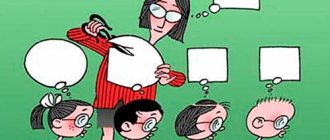We have all encountered stereotypical thinking, and it is perhaps difficult to find a person who has not heard what a stereotype is. Many of us believe that we are not susceptible to this phenomenon and are free from it, but this is practically impossible. Template thinking can manifest itself in small things that are not noticeable at first glance. What are the stereotypes, and is it worth fighting them?
Are stereotypes and prejudices the same thing?
In the literature you can often find the statement that stereotypes and prejudices are one and the same thing. Despite the fact that they have certain common features, it is wrong to combine these concepts.
Stereotypes are characterized as stable ideas about a person or situation, which are expressed in one’s own judgments, assessments, perceptions and usually do not need evidence. For example, there is a common stereotype: a woman driving is a bad and inattentive driver.
Prejudices are expressed as certain social personal attitudes that arise from insufficient knowledge or awareness and have prejudice. A prejudice widespread abroad: everyone in Russia drinks all the time.
The difference between the concepts is that prejudices in most cases express a negative perception of the person himself, an action or a situation and do not correspond to reality. For example, ethnic and racial prejudices, when a group of people of a certain nationality are attributed the same negative characteristics.
Stereotypes are not always negative; they often set a certain image that is known to most people and arises in the same way for everyone. For example, ice is hard and cold, but an open fire can burn you. One way or another, prejudice has a narrower concept and has some limitations.
How to get rid of stereotypes
Be aware of your stereotypes
To get rid of stereotypes, you first need to understand which of them you are susceptible to. There may be such a large number of them that it will cause confusion. If so, then choose the ten strongest or those that most destructively influence your life: gender, racial, religious prejudices.
You may also have negative views of musicians, scientists, drivers, children, government officials, and many other classes or groups. But if you realize this, you will take the first step in the right direction.
Recognize the negative effects of stereotypes
This step can be combined with the first because they are closely related. You must find out what bad stereotypes bring into your life. You need to observe all areas of life, even the most unexpected ones or those that at first glance seem not very important:
- Financial sphere.
- Social sphere.
- Physical health.
- Mental health.
For example, thinking of jocks as “dumb and uneducated” may turn you off from going to the gym forever. Well, who will you make worse by this?
You may find that many of your limiting beliefs are based on stereotypes. For example, you are 50 years old and you do not create your own business because you think that you are already too old for this. Although everyone knows examples where people even at an older age achieved enormous success in business.
Lower your self-esteem
To start, reduce your bias towards this advice. Actually, don’t many stereotypes appear due to inflated self-esteem? After all, it’s all immediately clear to him who and what he is. This is a form of ignorance.
Therefore, if you have high self-esteem, admit it to yourself. If you are afraid that such an approach will reduce the quality of life, then think again about the second point and what negative consequences stereotypes have. You will understand that this is a small price to pay to expand your worldview, make a lot of new acquaintances and truly socialize.
Find out the benefits of breaking free from stereotypes
Make a detailed list of how your thinking, beliefs, and values might change if you began to view every person you meet as an individual. Previously, you probably stuck dozens of labels on him, and he didn’t even have time to open his mouth. Judging a person from scratch – isn’t that more interesting?
Surround yourself with a variety of people. Yes, people who are similar to us are more pleasant, but it is so easy to become rusty in conformity. Travel more – at least to other cities.
We wish you good luck!
Did you like the article? Join our communities on social networks or our Telegram channel and don’t miss the release of new useful materials: TelegramVKontakteFacebook
We also recommend reading:
- Storytelling
- Critical analysis of information: quickly and easily
- Culture shock and how to overcome it
- Dynamic stereotype: is it good or bad?
- Distortions of perception and understanding in the process of communication
- Cognitive schemas
- Prejudice: mental poison
- Causes of prejudice
- Interesting things about cognitive distortions
- Not everything is what it seems
- Social groups: signs, types, functions
Key words: 1 Communication, 4 Self-knowledge
Types of social groups
It is known that the formation of stereotypes is influenced by the types of social groups. Representatives of a particular community of society have their own commitments and concepts. Let's look at this in more detail. Sociologists distinguish large, small, contact (or primary) and remote (or secondary) types of social groups.
- Large groups consist of large communities that occur on a global scale. For example, groups composed of social, professional, ethnic, age characteristics. Belonging to a particular group is formed through interaction with organizations that advocate for their rights. For example, a trade union, a national community, a student club, etc.
- Small groups - friends, neighbors, family, classroom, course. Interaction occurs at the level of personal and emotional contacts. There are specially and spontaneously created small groups, divided on the basis of joint activity, personal and social significance.
- Contact (or primary) groups are made up of close people who have stable personal connections: relationships between family members, close friends, classmates.
- Distance (or secondary) groups are made up of people who have formal or temporary relationships with each other - colleagues, acquaintances, connected by work matters.
It is important that in each group, depending on its character, activities and composition, its own social stereotypes are formed and prevail.
In the Netherlands everyone loves and uses intoxicating substances
Well, this opinion is mutual: the Dutch also believe that all tourists come here just for the weed. At the same time, they themselves do not use drugs, and many even consider it beneath their dignity to smoke weed. According to official data, only 5.4% of the country's residents regularly use intoxicating substances, which is lower than the European average of 6.8%.
Functions of social groups
American sociologist Neil Joseph Smelser identifies the following functions of social groups:
- Socialization function: only by being a member of a social group is an individual able to survive, start a family and raise children. A person cannot live alone outside of society; he will be doomed.
- Instrumentality function : a person cannot do without work, he must carry out some kind of activity that allows him to provide himself and his family with everything they need.
- An expressive function in which members of a social group must satisfy the need for respect, trust and goodwill towards each other.
- The supporting function, which aims people to unite in groups in difficult situations and determine joint actions.
One way or another, stereotypes formed in social groups with certain functions are not always true and often interfere with living a full life. Therefore, before succumbing to this or that judgment, you should understand yourself and your own concepts.
Originally Russian question
The victim of a stereotype can be either the relay of the misconception or the receiving party, a seemingly uninterested party. It’s funny, but in the vast expanses of our vast homeland there are wandering unique ones - two in one. This often occurs among teenagers who consciously choose a socially correct profession, throwing their natural abilities and abilities into the farthest corner of the darkest ideological closet.
The drama of intrapersonal contradiction is the active imposition of one’s own self-criticism on rigid parental stereotypes. The criteria of success, correctness, relevance - in general, the phenomena are very ambiguous, and then there is external pressure. Absolutely trouble! Indeed, in the modern world, such people sooner or later wash up on their “native” shores, but how much time is wasted!?
Before it’s too late, let’s look for the answer to the notorious classic question. What to do with all this mess? What to do if, among all of the above, you found your portrait or an example from your own life?
Naturally, the very first step is awareness of the problem . The second is the creation of a new model of the world . That model that will become your guiding star, a new map with which you can achieve peace and harmony in your own soul.
And the final, final and, perhaps, the most difficult step is accepting yourself as new, on the still old map of the world . Your brain, psyche, soul and even body will need some time to adapt. A somewhat mechanical formulation, but any process of learning and adoption of innovations has a biological nature. Even in such seemingly rather abstract things. This is by no means a five-minute process. Be patient and the boundaries of your world will become wider










